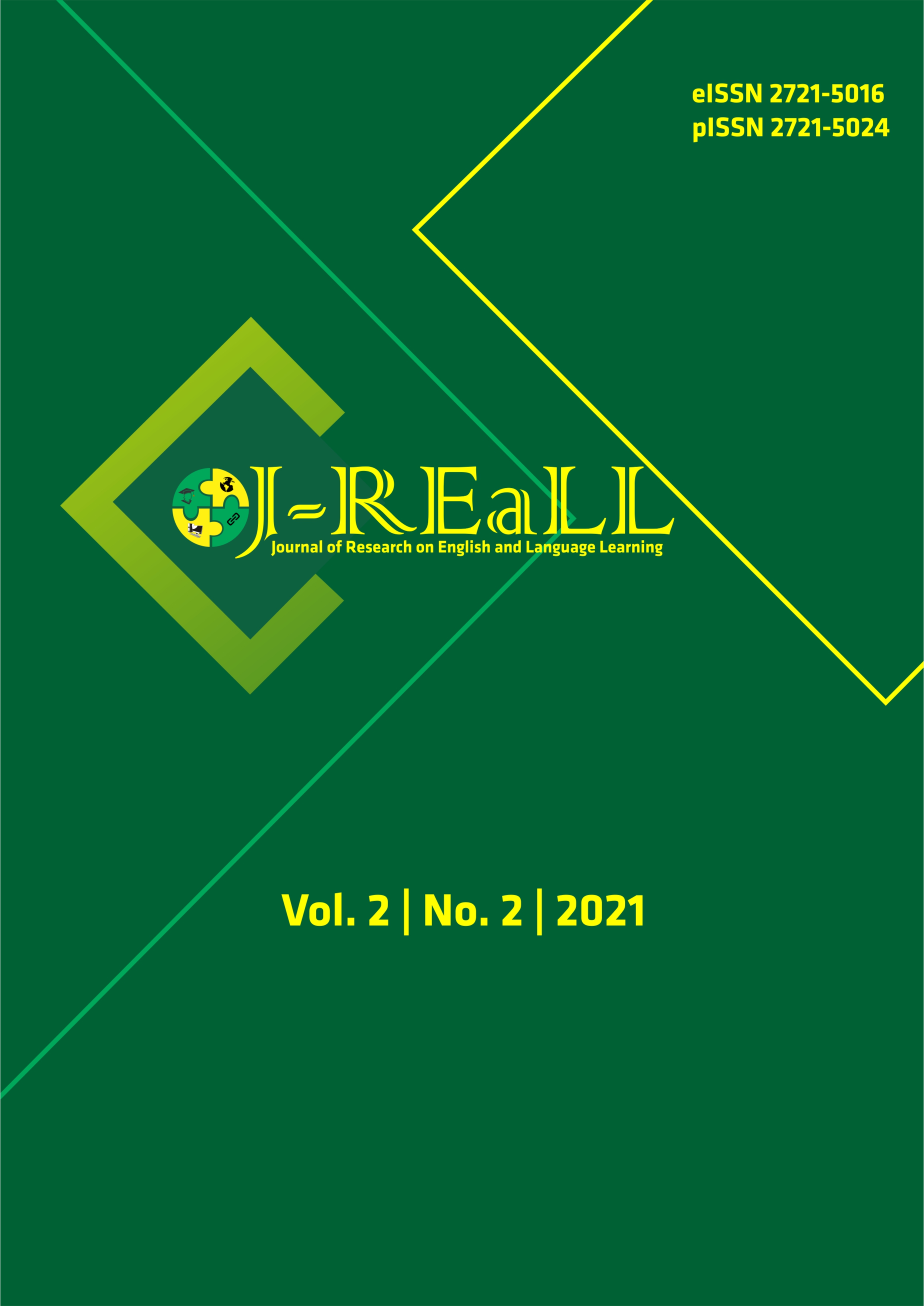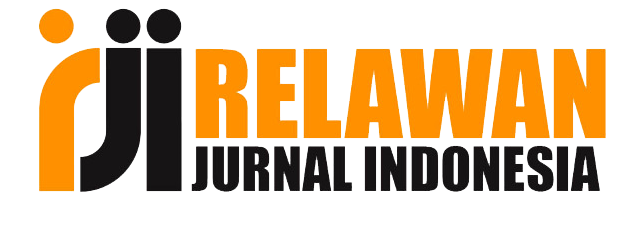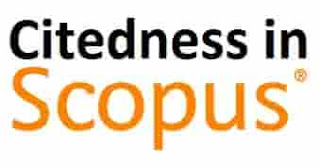EFL Students' Perceptions on stimulated-reflection (VSR) video as a learning strategy to increase speaking performance in Indonesia public university
DOI:
https://doi.org/10.33474/j-reall.v2i2.10953Keywords:
video stimulated-reflection, speaking performance, perception of students EFL.Abstract
Video-stimulated reflection has long been used in teaching and learning. One of the uses of video-stimulated reflection is in learning the English language. For this reason, this paper discusses students' perceptions in a private university in Jakarta, Indonesia, about applying the method of video stimulated-reflection as a learning strategy to increase speaking performance. There are two objectives in this study. The first objective was to reveal what is the EFL students' perception of video-stimulated reflection. The second objective was to know to what extent the video-stimulated reflection method helps students to enhance students speaking performance. Data were collected via journal reflection and interview. The data were analyzed by content analysis of the qualitative data. Four students of the private university were recruited to participate in this study. They were asked to record their speaking activities and complete journal reflection to capture their voice toward video-stimulated reflection. At the end of this research, an interview was also delivered by these students. The findings show that most students perceived positively toward video stimulated-reflection. Moreover, this study shows the strengths and weaknesses of video reviews; the problem faced when making the video, the aspect that needs to be improved, the efficiency of video stimulated-reflection, and students' focus when viewing the video. The findings are useful for EFL students involved in learning the use of video-stimulated reflection to enhance speaking performance.
References
Arp, A. (2016). Examining Student Metacognition when Self- Evaluating Public Speaking.
Baloian, N. A., Pino, J. A., & Ulrich Hoppe, H. (2000). A teaching/learning approach to CSCL. Proceedings of the 33rd Hawaii International Conference on System Sciences - 2000, 447-456. https://doi.org/10.1109/hicss.2000.926641
Chien, S.-Y., Hwang, H., & Siu-Yung Jong, M. (2019). Effects of Peer Assessment within the Context of Spherical Video-based Virtual Reality on EFL students' English-Speaking Performance and Learning Perceptionse. Computers & Education.
Christianson, M., Hoskins, C., & Watanabe, A. (2009). Evaluating the effectiveness of a video-recording based self-assessment system for academic speaking. Language Research Bulletin, 24, 1-15.
Cutrim Schmid, E. (2011). Video-stimulated reflection as a professional development tool in interactive whiteboard research. ReCALL, 23(3), 252-270. https://doi.org/10.1017/S0958344011000176
Encalada, M. A. R., & Sonia Magali Arteaga Sarmiento. (2019). Perceptions about Self-recording Videos to Develop EFL Speaking Skills in Two Ecuadorian Universities. Language Teaching and Research, 10(1), 60-67. https://doi.org/http://dx.doi.org/10.17507/jltr.1001.07
Gazdag, E., Nagy, K., & Szivák, J. (2019). "I Spy with My Little Eyes..." The use of video stimulated recall methodology in teacher training-The exploration of aims, goals and methodological characteristics of VSR methodology through systematic literature review. International Journal of Educational Research, 60-75. https://doi.org/10.1016/j.ijer.2019.02.015
Huang, Y. M., Huang, Y. M., Huang, S. H., & Lin, Y. T. (2011). A ubiquitous English vocabulary learning system: Evidence of active/passive attitudes vs. usefulness/ease-of-use. Computers and Education. https://doi.org/10.1016/j.compedu.2011.08.008
Kumar, A., Kumar, P., & Choton Basu, S. (2001). Student Perceptions of Virtual Education: An Exploratory study. Managing Information Technology in a Global Economy, the Proceedings of the Information Resources Manage- Ment Association International Conference, 400-404. http://www.idea-group.com
Lefebvre, L., Lefebvre, L., Blackburn, K., & Boyd, R. (2015). Student Estimates of Public Speaking Competency: The Meaning Extraction Helper and Video Self- evaluation. Communication Education, 64(3), 261-279. https://doi.org/10.1080/03634523.2015.1014384
Leinonen, T., Keune, A., Veermans, M., & Toikkanen, T. (2016). K-12 education. 47(1), 184-202. https://doi.org/10.1111/bjet.12224
Li, X. (2018). Teaching English oral presentations as a situated task in an EFL classroom: A quasi- experimental study of the effect of video-assisted self-reflection Enseñanza de presentaciones en inglés como tarea situada en el. REVISTA SIGNOS. ESTUDIOS DE LINGÜÍSTICA, 51(98), 359-381. https://doi.org/10.4067/S0718-09342018000300359
Longhurst, R. (2003). Semi Structured Interview and Focus Group. Key Methods in Geography, 103-115.
Mohamed, A., Yousef, F., Chatti, M. A., & Schroeder, U. (2014). Video-Based Learning: A Critical Analysis of The Research Published in 2003-2013 and Future Visions. 112-119.
Murphy, K., & Barry, S. (2016). Feed-forward: students gaining more from assessment via deeper engagement in videorecorded presentations. Assessment & Evaluation in Higher Education, 41(2), 213-227. https://doi.org/10.1080/02602938.2014.996206
Oberg, A., & Daniels, P. (2013). Analysis of the effect a student-centred mobile learning instructional method has on language acquisition. Computer Assisted Language Learning, 26(2), 177-196. https://doi.org/10.1080/09588221.2011.649484
Orlova, N. (2009). Video Recording as a Stimulus for Reflection in Pre-Service EFL Teacher Training. English Teaching Forum, 47, p30-35. http://eric.ed.gov/?id=EJ923452
Piccoli, G., Ahmad, R., & Ives, B. (2001). Web-based virtual learning environments: A research framework and a preliminary assessment of effectiveness in basic it skills training. MIS Quarterly, 25(4), 401-426. https://doi.org/10.2307/3250989
Putri, R. N., & Rahmani, B. D. (2019). Students Perception on Using Video Recording to Improve Their Speaking Accuracy and Fluency. UHAMKA International Conference on ELT and CALL (UICELL), November, 21-22.
Rosalina, R., Mulyono, H., & Dewi, N. K. (2019). Reflective teaching of an in-service EFL teacher to improve a professional skill. ICASI. https://doi.org/10.4108/eai.18-7-2019.2288651
Sari, A. B. P., Dardjito, H., & Dinar, M. A. (2020). EFL students' improvement through the reflective youtube video project. International Journal of Instruction, 13(4), 393-408. https://doi.org/10.29333/iji.2020.13425a
Shih, R. (2010). Blended learning using video-based blogs: Public speaking for English as a second language students. Australasian Journal of Educational Technology, 26(6), 883-897.
Soto, S. T., Cevallos, L. F. E., & Fontaines-Ruiz, T. (2017). How does explaining content through videos benefit language learners? ESP students tell us about it. Turkish Online Journal of Educational Technology, 385-391.
Sun, Y., & Yang, F. (2013). I help , therefore , I learn: service learning on Web 2 . 0 in an EFL speaking class. December 2014. https://doi.org/10.1080/09588221.2013.818555
Taj, I. H., Sulan, N. B., Sipra, M. A., & Ahmad, W. (2016). Impact of mobile assisted language learning (MALL) on EFL: A meta-analysis. 7(2). https://doi.org/10.7575/aiac.alls.v.7n.2p.76
Ting, N. C. (2013). Classroom Video Project: An Investigation on Students Perception. Procedia - Social and Behavioral Sciences, 90, 441-448. https://doi.org/10.1016/j.sbspro.2013.07.113
Traxler, J. (2010). Students and mobile devices. ALT-J: Research in Learning Technology, 18(2), 149-160. https://doi.org/10.1080/09687769.2010.492847
Vez López, E., & Bertani Tepetla, V. (2017). The impact of self-video recordings in raising oral production. 76-101. https://doi.org/10.15446/male.n11.71855
Vural, Ö. F. (2013). The impact of a question-embedded video-based learning tool on E-learning. 13(2), 1315-1323.
Wulandari, M. (2019). Improving EFL learners' speaking proficiency through instagram vlog. LLT Journal: A Journal on Language and Language Teaching, 22(1), 111-125.
Youn Ahn, T., & Lee, S. (2016). User experience of a mobile speaking application with automatic speech recognition for EFL learning. 47(4), 778-786. https://doi.org/10.1111/bjet.12354
Zhang, D., Zhou, L., Briggs, R. O., & Nunamaker, J. F. (2006). Instructional video in e-learning: Assessing the impact of interactive video on learning effectiveness. Information and Management, 43(1), 15-27. https://doi.org/10.1016/j.im.2005.01.004
Zulaiha, S., & Mulyono, H. (2018). Preservice EFL teachers' talk during a teaching practicum at a lower secondary school : A report on video-stimulated reflection ( VSR ). Argentinian Journal of Applied Linguistics, 6(1), 44-60.
Downloads
Published
How to Cite
Issue
Section
License
Copyright (c) 2021 Nurul Fadhla

This work is licensed under a Creative Commons Attribution 4.0 International License.
Authors who publish this journal agree to the following terms:
- Authors retain copyright and grant the journal right of first publication with the work simultaneously licensed under a Creative Commons Attribution License that allows others to share the work with an acknowledgement of the work's authorship and initial publication in this journal.
- Authors can separately make additional contractual arrangements for non-exclusive distribution published by the journal (e.g., publish it in a book), with an acknowledgement of its initial publication in this journal.
- Authors are allowed and encouraged to send their work via online (e.g., in the institutional repositories or their website) after published by the journal.






















